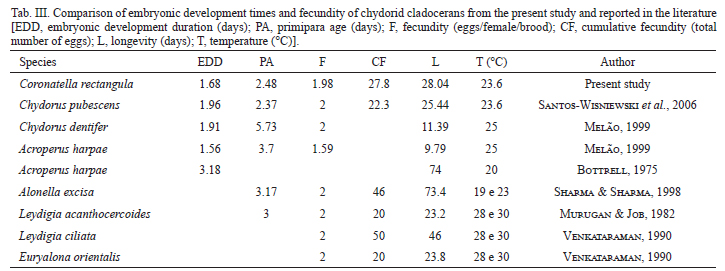Species of Chydoridae provide the main diversity of the Cladocera. These organisms have been the subject of many studies; some dealing with their role in energy flow in aquatic ecosystems, since they inhabit the littoral region of water bodies which undergo the first impacts from anthropic activities. The aim of this study is to increase knowledge about the life cycle of Coronatella rectangula (Sars, 1861), a species found in several water bodies in the state of Minas Gerais, Brazil. The life cycle was determined by the culture of parthenogenetic females under controlled conditions in the laboratory. Experimental cultures were maintained in growth chambers at a constant temperature of 23.6(±0.5)ºC, through a 12 h light/12 h dark photoperiod. The organisms were fed on a suspension of Pseudokirchneriella subcapitata (Chlorophyceae) (10(5) cells.mL-1), and 0.02 mL of a mixed suspension of yeast and fish ration added per organism in equal proportions (1:1). Fifty parthenogenetic females with eggs were isolated and maintained until they produced neonates. Thirty of these neonates that had less than 24 hours were put in polypropylene bottles of 50 mL and kept in a germination chamber. These organisms were observed daily to obtain the parameters of the life cycle. Biomass and secondary production were also calculated. The embryonic development time of the specimens of C. rectangula was 1.68(±0.13) days and the time to reach primipara, was 2.48(±0.45) days. The mean fecundity of C. rectangula was two eggs/female/brood and the total number of eggs produced by the female during its life cycle was 27.8 eggs. During the whole life cycle, specimens of C. rectangula had a maximum of 14 seedlings, with two instars in the juvenile stage. Total biomass for C. rectangula was 36.66 µgDW.m-3(9.83 for the juvenile stage and 26.82 µgDW.m-3 for adults), and secondary production was 12.10 µgDW.m-3.day-1(8.34 µgDW.m-3.day-1 for egg production and 3.76 µgDW.m-3.day-1 for the juvenile stage).
Life cycle; Cladocera; littoral region; phytophilous organisms





